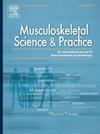Acceptability of a 12-week movement program (Motum) to address functional outcomes in people with chronic non-specific low back pain: a mixed methods pilot study
IF 2.2
3区 医学
Q1 REHABILITATION
引用次数: 0
Abstract
Introduction
Chronic non-specific low back pain (CNSLBP) is a major cause of disability globally. Due to the multifactorial nature of CNSLBP, non-pharmacological management such as exercise therapy, has been recommended as a first-line treatment. This pilot study examined the acceptability and clinical impact of a novel physiotherapist-led movement-based intervention for people with CNSLBP.
Methods
A mixed-methods study design was used. Twenty-nine adults with CNSLBP were allocated to a 12-week movement-based program (Motum) or waitlist control. The intervention comprised 12 sessions based on fundamental movement patterns and motor control principles. The primary outcome was acceptability and secondary measures were balance, pain, function, self-efficacy and kinesiophobia. Semi-structured interviews explored participants experiences of the intervention.
Results
The intervention was acceptable to participants with all sub-domains (affective attitude, perceived effectiveness, intervention coherence, opportunity costs, self-efficacy, and ethicality) scoring ‘highly acceptable’ (p < .001), except burden which scored ‘acceptable’ (p < .02). The intervention demonstrated large positive changes for improving fear avoidance of movement (Hedges g = .92) and balance (g = 1.04) and smaller positive effects on pain and function (g = .62) and self-efficacy (g = .23), compared to controls. Themes emerging from qualitative data with 10 participants were: 1) acceptability of program structure; 2) positive impacts attributed to the intervention; and 3) barriers to engagement.
Conclusion
Motum was an acceptable intervention and demonstrated positive impacts across a range of clinical outcomes. While these findings are encouraging, further research through mature study designs (such as randomised controlled trials) are required to substantiate these findings.
12周运动计划(Motum)对慢性非特异性腰痛患者功能结局的可接受性:一项混合方法的试点研究
慢性非特异性腰痛(CNSLBP)是全球致残的主要原因。由于CNSLBP的多因素性质,非药物管理如运动治疗,已被推荐作为一线治疗。本初步研究考察了一种新的物理治疗师主导的基于运动的CNSLBP患者干预的可接受性和临床影响。方法:采用混合方法设计研究。29名患有CNSLBP的成年人被分配到一个为期12周的基于运动的项目(Motum)或候补名单控制。干预包括基于基本运动模式和运动控制原理的12个疗程。主要指标是可接受性,次要指标是平衡、疼痛、功能、自我效能和运动恐惧症。半结构化访谈探讨了参与者对干预的体验。结果:所有子领域(情感态度、感知有效性、干预一致性、机会成本、自我效能和道德)得分为“高度可接受”的参与者都可以接受干预(p结论:Motum是一种可接受的干预,并在一系列临床结果中表现出积极的影响。虽然这些发现令人鼓舞,但需要通过成熟的研究设计(如随机对照试验)进行进一步的研究来证实这些发现。
本文章由计算机程序翻译,如有差异,请以英文原文为准。
求助全文
约1分钟内获得全文
求助全文
来源期刊

Musculoskeletal Science and Practice
Health Professions-Physical Therapy, Sports Therapy and Rehabilitation
CiteScore
4.10
自引率
8.70%
发文量
152
审稿时长
48 days
期刊介绍:
Musculoskeletal Science & Practice, international journal of musculoskeletal physiotherapy, is a peer-reviewed international journal (previously Manual Therapy), publishing high quality original research, review and Masterclass articles that contribute to improving the clinical understanding of appropriate care processes for musculoskeletal disorders. The journal publishes articles that influence or add to the body of evidence on diagnostic and therapeutic processes, patient centered care, guidelines for musculoskeletal therapeutics and theoretical models that support developments in assessment, diagnosis, clinical reasoning and interventions.
 求助内容:
求助内容: 应助结果提醒方式:
应助结果提醒方式:


